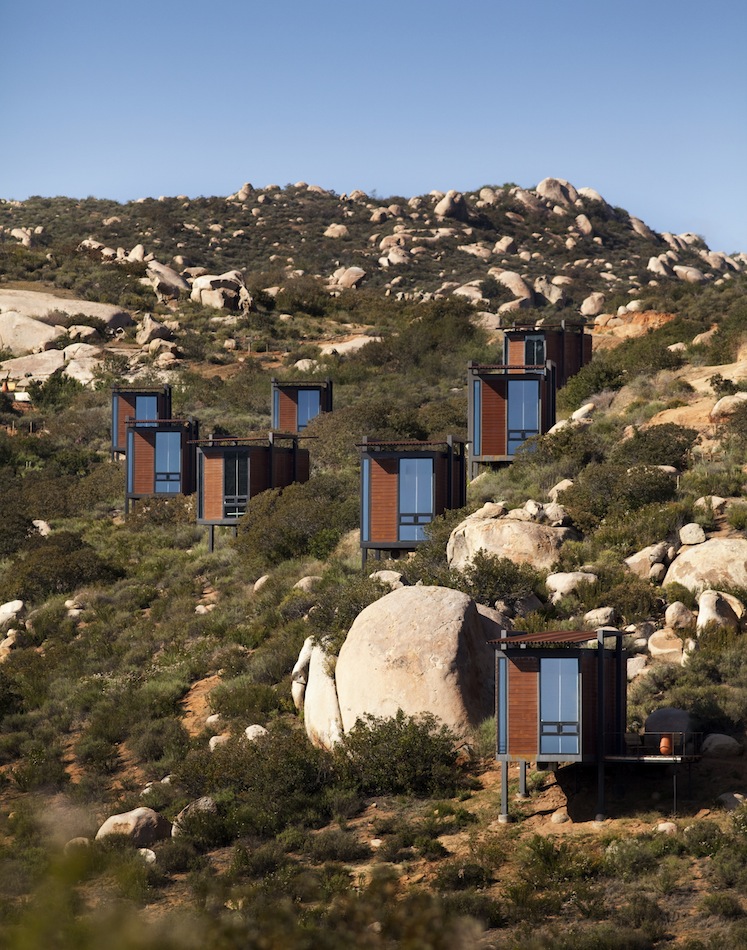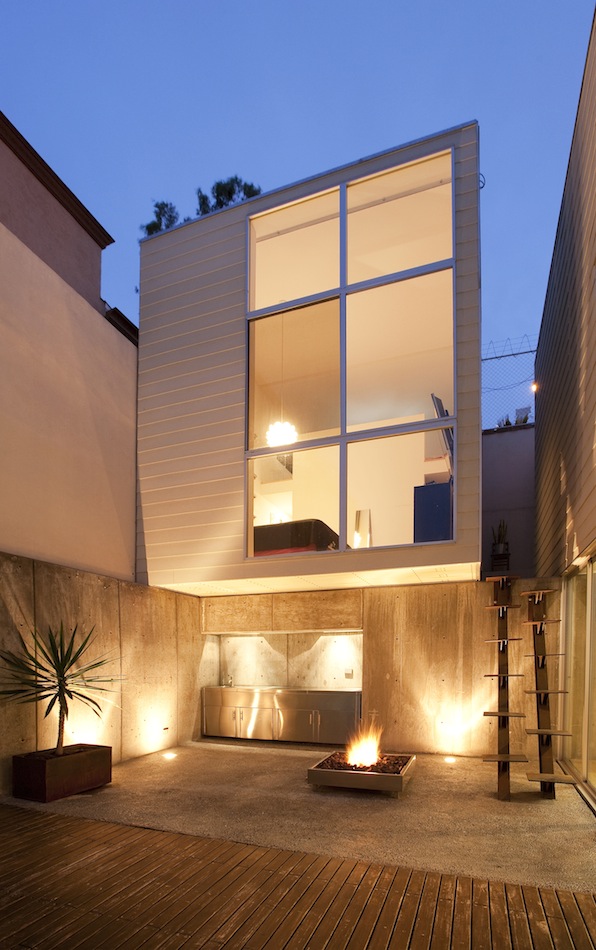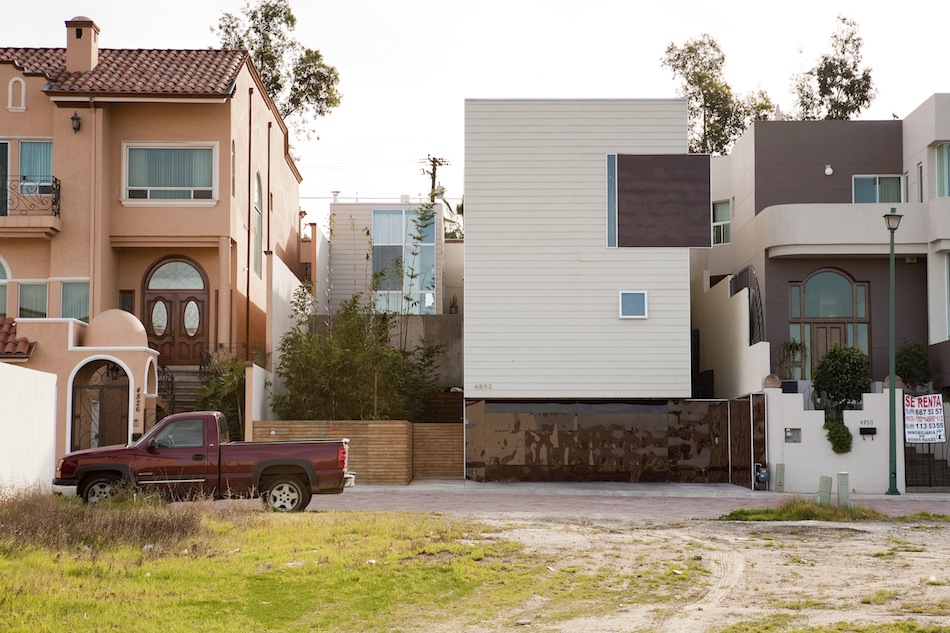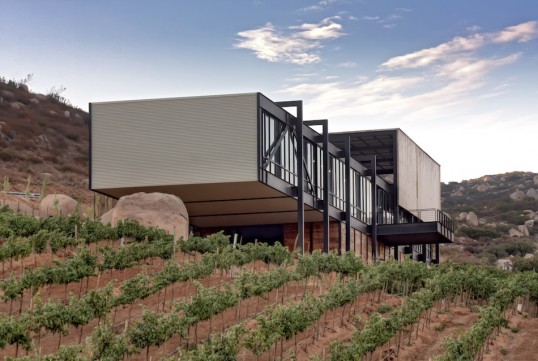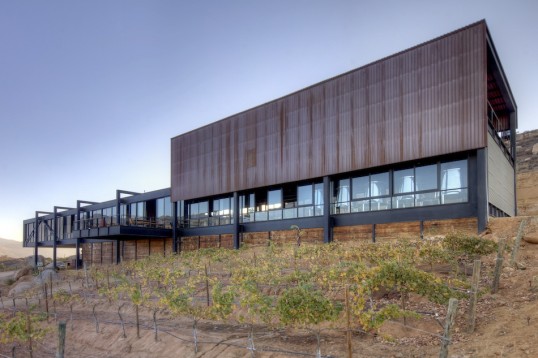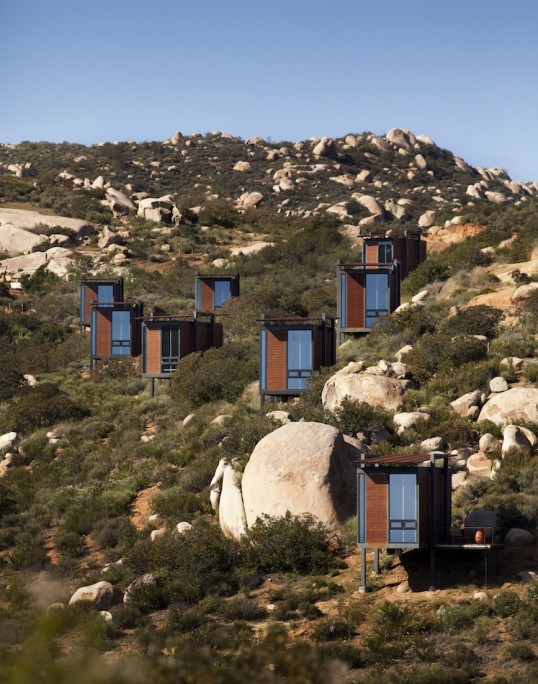Interview: graciastudio
EMERGING VOICE 2013
graciastudio
With offices in both Tijuana and San Diego, graciastudio designs buildings that reflect the influences of regional labor, materials, and markets on construction. Led by Jorge Gracia, the studio has focused on prefabricated architecture, and sees economic constraints as an opportunity for architects to develop creativity and inventiveness. Recent work includes the Culinary Art School and CAS Hotel, both in Tijuana, and the Encuentro Guadalupe, a mixed-used residential-hotel community in Ensenada, Mexico. On the occasion of his lecture (video below), Jorge Gracia sat down with League Program Director Anne Rieselbach to discuss his practice.
Anne Rieselbach: This series emphasizes the voice of practitioners, how would you describe your voice?
Jorge Gracia: In the context of the area where I work, I see my voice as one that is yelling. Trying to make things happen in a city like Tijuana sometimes requires a loud voice. I am a very calm person, but I see it as a means of expression. It seems necessary since, in my opinion, a lot of things have gone down the wrong path in my city. Development in Tijuana is creating bad copies of American suburbs, which is a serious issue, since they are so disconnected and require that you drive everywhere. A lot of people like to blame this on the clients, saying they request it to be this way, but in actuality it is primarily happening because of a lack of creative proposals. Development is occurring along a path of least resistance; the city just says yes to everything. It’s a city that accepts all ideas.
AR: As an emerging firm, what do you see as the advantages and challenges to practice in today’s economic, professional, and intellectual climate?
JG: Well, I think that when options become more limited, people become more creative. So I don’t see it as a problem, so much as an opportunity to do things differently. One time I was invited to be on the jury for a competition at a culinary school that we built. They only gave each contestant 50 pesos to go to the store and buy ingredients. That pressure produced some pretty amazing results–it’s the same thing we do as architects.

Click for a project slideshow. Endemico Resguardo Silvestre, Valle de Guadalupe, Ensenada (Mexico) | photo: Luis Garcia
AR: Could you talk about the role of improvisation in your work?
JG: Of course, when we are designing we’re always thinking how we’re going to build, but if you look at our setup drawings, for example, they come from a general idea–they are not completely finished when we start construction. We leave that gap so that we can allow the construction process to influence the design, and give ourselves a chance to change our minds about the materials. I think it’s something you really have to feel. It’s almost more like sculpture. But those kinds of things can only happen in certain cities.
AR: You’ve been an independent practice for ten years now, with most of your work in the Tijuana area. How did your design/build process develop? What effect has the environment had?
JG: The way we’re doing architecture in our studio is very much in response to what’s happening out there in the region. And every client is different. Most of our clients trust us, and let us do whatever we want. They trust us because at the end, we’re doing something creative and we’re respecting the budget: we’re not asking them to spend more on the project. Too often with other firms I see them thinking about the photo at the end of the project or trying to use the latest materials on the market. We try to use what is out there and work from there. I just go to the hardware store and say, “let’s do something, let’s cook.”
AR: Tell me more about the multidisciplinary school of practical architecture that your firm founded. What is the relationship between the school and your work’s emphasis on craft?
Trying to make things happen in a city like Tijuana sometimes requires a loud voice.
JG: We started the school because we wanted to give these very recent architecture graduates a very practical set of skills: to introduce them to the service providers, the craftsmen, etc. We try to share our entire professional “infrastructure” with the students, because when they have an idea, we want them to be able to realize it, in terms of design, craft, and economics. Right now we’re just doing one-month classes, but next year the full-time school will start.
AR: How many students do you have at a time?
JG: Groups of 15, roughly. They’re mostly architecture students, but there was one civil engineer and some interior designers. There were even clients who called me wanting to go to class! I think the school is important because when I first left school, there weren’t enough places in Tijuana to work, to gain these kinds of skills. I’m trying to build this little army of students to really be able to make a difference in the city. Obviously, one cannot do it alone.
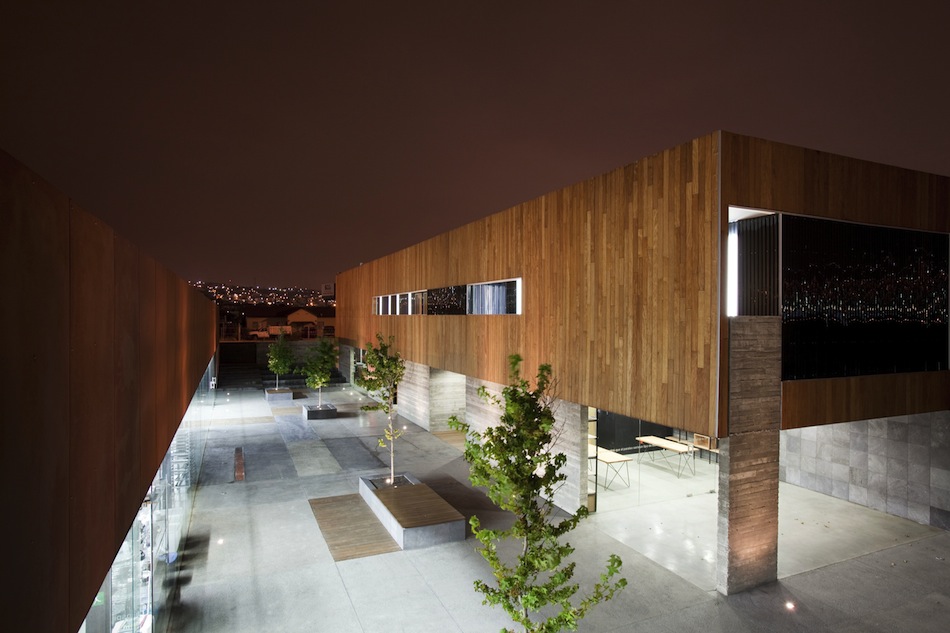
Culinary Art School, Tijuana (Mexico) | photo: Luis Garcia
AR: You’re training architects in that respect, but on the other hand, with projects like the Todos Santos house, where the lack of experienced labor and the high cost of construction materials led to a project that called for local labor, you are training and supervising on the job site as well.
JG: Yes, it started with our first project in 2004. We were getting workers who were not traditionally trained, but we started building a relationship with them. And we’ve been using the same workers since then. They may have not been the best guys in the field when they started, but they learned the specific way we build, which is not the usual building system using concrete masonry unit (CMU) block walls. We’re training them to work with galvanized poles, metal, wood, all of these different materials and different claddings–they’re already very into it. That makes it a lot easier to start a project for us. We don’t even need to have the whole construction set, because all of workers know how we work. When we’re in the studio, we invite the carpenter, and he sits back while we’re designing; we’re taking his considerations into design. He will often give us advice about how the design can be adapted to be built the easiest way.
AR: So improvisation is not just happening in the field, it is in the office as well.
JG: It’s mainly in the office. It’s in the office with the guys in the back telling us, “No, don’t do it that way, do it this way.” Taking some of the ego out of the architect and giving it to the workers makes everything easier. In the United States, the contractors are always fighting with the architects, but in our case, we don’t have any conflict with our direct employees.
AR: Your work has a very minimal palette, but exploits the potential of inexpensive materials, often reusing the formwork for one thing or another. Is that of necessity, intention, or a combination?
JG: I’m always trying to use materials that I haven’t seen before. Sometimes the result looks original, sometimes it’s as if you’ve already seen it, but I always try to experiment with different materials. Some, in the end, don’t work very well, but that’s in the spirit of experimentation. The polycarbonate, for example, I don’t use anymore, because after a while it gets very dirty and a little bit yellow. Those are the things you learn as an architect. They say, for a good architect, it takes a really long time to understand. I’m not worried.
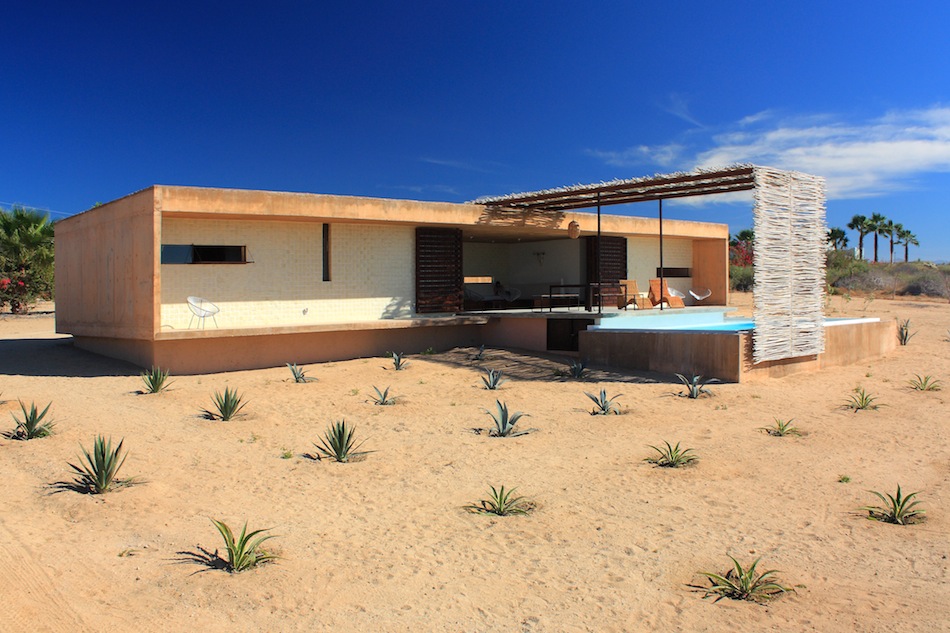
Casa Todos Santos, BCS (Mexico) | photo: Sandra Munoz
AR: Much of your work responds to the particular and varied topography of the Baja Peninsula, with surprising contrasts between projects: such as the low lying, really simple form of the Casa Todos Santos to the raised ecolofts of the Endémeco Resguardo Silvestre. What factors go into the initial program of each project in your formal response to the site?
JG: It might sound very romantic, but I find I really need to get to the site–to be there during the day, and to stay at night–in order to grasp all its different stages and try to understand the airflow, the sun, all of those details.
AR: By comparison, your city projects are typically inward looking.
JG: Yes, if I were in a different city, where you can look outside and everything is beautiful, it might be different; but in Tijuana, not everything is so beautiful. Sometimes you want to turn inward. Of course it is very dependent on the context of each project. But for the projects in more natural settings, it’s about trying hard to understand the physical environment. I say “trying” because you might only begin to understand it while you are building; and then, only if you are lucky.
AR: If you had a dream project to work on in the future, what would that be?
JG: I would like to be proposing projects for the city. In Tijuana, some of my friends are going into politics, some are business owners, or architects, and I think that working together creates an opportunity to really do something. Perhaps I’ll have to become a politician. Right now our studio is consulting for the government on development projects, but the idea is to do that work with the school once it’s up and running. The goal is to have real, civic projects at the school, supervised by us so that at the end something concrete can be delivered. It’s about connections–there are a lot of companies from San Diego, for instance, that help people in Tijuana build houses. So if we can get the architecture school in contact with the government, and then with the organizations in the United States that give development money to Mexico, I think the projects at the school can be done. That could have a big impact, and we’re very excited about that.
•••
Jorge Gracia, graciastudio, Emerging Voices 2013, complete lecture video | Recorded March 7, 2013 | Running time: 40:23
•••
Jorge Gracia received a B.Arch and a M.Int.Bus from Universidad Iberoamericana Noroeste and currently teaches at the Universidad Iberoamericana (Tijuana) and Escuela Libre de Arquitectura (Tijuana). The office was recently featured in Architectural Record’s Design Vanguard issue. See more of their work at graciastudio.com.
The Emerging Voices award spotlights individuals and firms based in the United States, Canada, or Mexico with distinct design voices and the potential to influence the disciplines of architecture, landscape design, and urbanism. Click here for more on the 2013 Emerging Voices, or see the complete list of past winners here.



